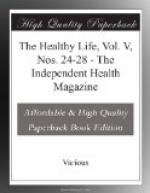any idea, in spite of all the teaching and the advocacy
of it, of really deep and scientific breathing.
If the system could be made quite general and enforced
upon us—especially when young or adolescent—we
should not see, as we do now, thousands walking
about the streets whose nostrils are too narrow through
insufficient breathing, whose lungs are not properly
inflated as they inspire; and, as a consequence,
who have neither the bloom nor the carriage of health.
Perhaps if I show here how vastly important it is for us to have our blood well oxygenated, it may be some sort of encouragement for Mrs Lazarus’s readers to persevere with and work into their lives the system she advocates and describes.
If we did not renew the oxygen in our lungs to a sufficient extent, we should die in a few minutes. We can do without food for many days; without water for less days, but only for a few minutes without oxygen. Anything which tends to increase the intake of this vitally important element, whether deeper breathing or exercises, will have a very pronounced effect upon our general health. Now deep breathing is, par excellence, the way to bring about this desirable condition. It may interest the readers of this little book if I remind them that in the ordinary way the total capacity of the lungs is about 340 cubic inches; as a rule, the amount of air breathed amounts only to some 20 or 30 cubic inches, but this, by special effort, can be increased by some 110 cubic inches. Thus it is demonstrated how much more air we could take into the lungs by better and deeper breathing, thereby securing, sooner or later, a greater natural expansion of the lungs, with the result, of course, of improved health generally.
It would surprise most people if they tested their breathing capacity by the aid of the spirometer, to discover how inefficiently they did breathe; in other words, how much below the normal was the amount of air they were usually inspiring. Encouragement might also be found in the matter—incentive, that is, to learn how to breathe and exercise correctly and scientifically—if mention were here made categorically of the very profound influences upon certain physiological processes of our organisation which are brought about if we would but mend our ways in this respect. Space will only allow of a few such to be detailed.
1. The circulation is improved and equalised. This implies much more than appears on the surface: it means that the blood is made to flow from any congested internal organ (such as the liver, stomach, etc.) towards the peripheries—that is, the extremities and everywhere where there is the capillary system—the changing-place between the venous and the arterial blood; thus we at the same time warm our extremities and relieve internal congestion. In other words, “to bring the blood to the surface” in many conditions




